
Myrmicinae is a subfamily of ants, with about 140 extant genera; their distribution is cosmopolitan. The pupae lack cocoons. Some species retain a functional sting. The petioles of Myrmicinae consist of two nodes. The nests are permanent and in soil, rotting wood, under stones, or in trees.

Cephalotes is a genus of tree-dwelling ant species from the Americas, commonly known as turtle ants. All appear to be gliding ants, with the ability to "parachute" and steer their fall so as to land back on the tree trunk rather than fall to the ground, which is often flooded.
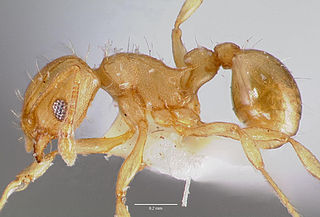
Wasmannia is a genus of ants. Wasmannia auropunctata is known as the electric ant or little fire ant and are considered by many countries to be a destructive, highly invasive species.

The Aphnaeinae are a subfamily of butterflies in the family Lycaenidae.

Megalomyrmex is a genus of ant in the subfamily Myrmicinae. The genus is known only from the Neotropics, where some of the species are specialized parasites or predators of Attini.
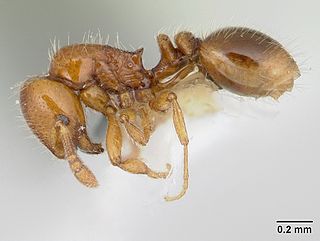
Oxyepoecus is a Neotropical genus of ant in the subfamily Myrmicinae. The genus is a member of the tribe Solenopsidini and currently includes 20 species.

Pseudomyrmex is a genus of stinging, wasp-like ants in the subfamily Pseudomyrmecinae. They are large-eyed, slender ants, found mainly in tropical and subtropical regions of the New World.

Pachycondyla is a ponerine genus of ants found in the Neotropics.

Pseudonocardia is a genus of the bacteria family Pseudonocardiaceae. Members of this genus have been found living mutualistically on the cuticle of the leafcutter ants because the bacteria has antibiotic properties that protect the fungus grown by the ants. When they are grooming, their legs are passed over their mouth gland that produces the antibiotic and then their legs touch the fungi while they are walking around. The ants have metapleural glands that produce the antimicrobial components to eliminate the Escovopsis fungi. The bacteria may also be found in crypts on the propleural plate. Pseudonocardia is found to have antibiotic properties provided to the leaf-cutter ant to inhibit the growth of Escovopsis, which is a black yeast that parasitizes the leaf-cutter ant. Pseudonocardia can be found in both aquatic and terrestrial ecosystems. Pseudonocardia belongs to the phylum Actinobacteria. Most Actinobacteria grow in soils that are of a neutral pH. Actinobacteria are also important in plant-associated microbial communities are referred to as "free-living." This means that they are not dependent on another organism to live. For example: A non-free-living organism would be a parasite that depends on a host as a food source and a place for shelter. "Free-living" also allows these organisms to require less energy and food for survival. Bacteria from the Pseudonocardia genus are catalase-positive, non-motile, aerobic, non-acid-fast and produce a gram positive reaction. Under the microscope they exhibit branching, rod-shaped organisms.
There are many different strains of Pseudonocardia and a good portion of these strains have been found in China, in soils of the forest, and in Eucalyptus trees of Australia.

Procryptocerus is a Neotropical genus of gliding ants, with the ability to "parachute" by steering their fall if they drop off of the tree they're on.

Trachymyrmex is a genus of fungus-growing ants in the subfamily Myrmicinae. The genus is mainly tropical in distribution, with most species being found in Central and South America.

Dolichoderus is a genus of ants found worldwide.

Rhopalothrix is a genus of ants in the subfamily Myrmicinae.

Agroecomyrmecinae is a subfamily of ants containing two extant and two fossil genera. The subfamily was originally classified in 1930 by Carpenter as Agroecomyrmecini, a Myrmicinae tribe. Bolton raised the tribe to subfamily status in 2003, suggesting that Agroecomyrmecinae might be the sister taxon to Myrmicinae. It has since been discovered to be one of the earliest lineages of ants, a clade from the basal polytomy for all ants. In 2014, the subfamily was expanded to two tribes. The tribe Ankylomyrmini was moved from the subfamily Myrmicinae to Agroemyrmecinae.

Tatuidris, or armadillo ant, is a rare genus of ants consisting of a single species, Tatuidris tatusia. The ants are small in size and inhabit the leaf litter of Neotropical forests in Central and South America, from Mexico to Brazil. Workers are ferruginous-colored to dark red and present a distinctive morphology, consisting of a shield-like head with a broad vertex, ventrally-turned heavy mandibles which do not overlap at full closure, and unique among ants – an antenna socket apparatus sitting upside-down. Little is known about the biology of the ants, but they are likely nocturnal and specialist predators.
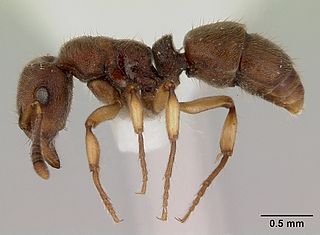
Heteroponera is a genus of ants in the subfamily Heteroponerinae. The genus is known from the Neotropics and Australasia.
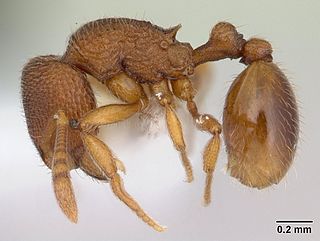
Rogeria is a genus of ant in the subfamily Myrmicinae. The genus is known from the Americas, Pacific, and Caribbean. Little is known about their biology.

Ooceraea is a genus of ants in the subfamily Dorylinae containing approximately 16 described species. The genus is distributed across the Australasia, Indomalaya, Malagasy, Neotropical, Oceania, and Palearctic bioregions. Ooceraea was described by Roger (1862) and later placed as a junior synonym of Cerapachys by Brown (1973). Ooceraea was resurrected as a valid genus by Borowiec (2016) during redescription of the doryline genera.

Syscia is a genus of ants in the subfamily Dorylinae containing thirty eight described species. The genus is distributed widely across the Eastern Asia, North America, and South America. Syscia was described by Roger (1861), later placed as a Cerapachys subgenus by Wheeler (1902) and then junior synonym of Cerapachys by Kempf (1972). Syscia was resurrected as a valid genus by Borowiec (2016) during redescription of the doryline genera.
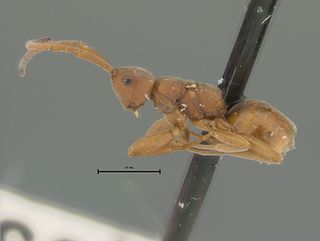
Embolemidae is a family of small solitary parasitoid wasps with around 70 species in 2 genera distributed around the world. The few species whose biology is known are parasites on planthopper nymphs of the families Achilidae and Cixiidae. There is debate regarding the status of the genus named Ampulicomorpha by Ashmead in 1893, generally considered now to be a junior synonym of Embolemus (e.g.,), though some authorities dispute this (e.g.,)




















